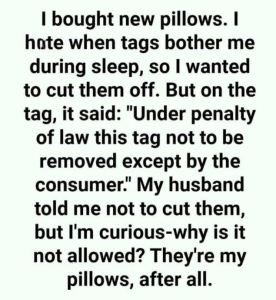Is It Really Illegal to Cut Off That Pillow Tag? Here’s the Truth Behind the Label
We’ve all seen it: the long, crinkly tag dangling from our pillows, mattresses, or cushions that reads something like:
“UNDER PENALTY OF LAW THIS TAG NOT TO BE REMOVED EXCEPT BY THE CONSUMER.”
For generations, it’s been a point of confusion — and even fear. Does removing the tag mean you’re breaking the law? Will some federal agency come knocking because you wanted to snip off an annoying piece of fabric?
Let’s unravel this mystery. The short answer? No, it’s not illegal for you, the consumer, to remove the tag. But the long answer is far more interesting — and it reveals a history rooted in consumer protection, manufacturing ethics, and some strange 20th-century fears.
Where Did the Tag Law Come From? A Glimpse Into History
To understand the truth, we have to go back more than a century.
In the early 1900s, as the mass production of consumer goods skyrocketed, so did the risks to consumers. Unscrupulous manufacturers often stuffed pillows, cushions, and mattresses with whatever cheap filler they could find — horse hair, newspaper, old rags, or even sawdust — then sold them as new and high-quality.
There was no easy way for a consumer to know what was inside their bedding. And in an age before federal safety regulations, this wasn’t just deceptive — it could be dangerous. Used materials could carry disease or pests, and consumers had no way of protecting themselves.
In response, states began passing laws requiring manufacturers to list exactly what was inside products like pillows and mattresses. To enforce this, they required tags that could not be removed before purchase. The tag had to stay on the product all the way to the end buyer — the consumer — so no middleman could switch it out or misrepresent the product.
The Key Phrase: “Except by the Consumer”
The language on the tag often reads:
“UNDER PENALTY OF LAW THIS TAG NOT TO BE REMOVED EXCEPT BY THE CONSUMER.”
That bold, stern warning has given generations of people the false impression that removing the tag is illegal under any circumstance. But the key is in that last part: “except by the consumer.”
That means the law does not apply to you once you’ve bought the item. The warning is meant for retailers and manufacturers, not the people who sleep on the pillow or sit on the cushion.
It’s legal — and totally safe — for you to remove the tag once you own the product. You can snip it, tear it, toss it in the trash, or save it in a scrapbook if you want. No federal bedding task force is going to show up at your door.
Why the Language Sounds So Scary
The wording is deliberately forceful, and for good reason — it’s aimed at ensuring that information stays with the product until the consumer has had a chance to see it.
Before laws like this, resellers or unethical dealers might buy bulk cheap mattresses, remove any original label, and replace it with something that said “100% new foam” when it was actually full of used material.
By mandating that only the end user could remove the label, lawmakers ensured that you — the consumer — would always be able to see what you were buying.
But over time, the warning label became a joke and a source of confusion. Even cartoons and comedy skits have played on the myth that “cutting off the tag is a federal crime.” In reality, once it’s in your hands, the government couldn’t care less what you do with it.
So What Happens If a Retailer Removes It?
Here’s where the law does apply. If a manufacturer, importer, or retailer removes or alters the tag before the item is sold, they are breaking the law. That’s because they are interfering with a consumer’s right to know what’s inside the product.
Each state has its own rules, but most mirror the guidelines established by federal truth-in-labeling standards. Some violations can result in fines or sanctions. These laws are still enforced today, particularly for mattresses, which are also regulated for flammability and hygiene.
What’s on the Label Anyway?
While most of us ignore the fine print, the label is there to inform you about the materials inside. It usually lists things like:
-
Filling material (e.g., polyurethane foam, polyester fiber, memory foam)
-
Percentage composition
-
Certification (e.g., “All new material” vs. “Recycled content”)
-
Manufacturer information
-
Registration number (which identifies the maker and can be looked up)
In the case of mattresses and pillows, this information can be particularly important for people with allergies, chemical sensitivities, or children. If you’re someone who wants to avoid certain synthetics or off-gassing materials, the label gives you vital information.
Modern Tags Still Serve a Purpose
Even though the days of sawdust-stuffed pillows are mostly behind us, these tags still serve a purpose in today’s market.
-
They help regulators spot counterfeit or unsafe products
-
They protect honest manufacturers
-
They provide safety information (like flammability warnings)
-
They’re crucial in recalls — if a mattress gets recalled for fire risk or chemical exposure, the registration number on the tag helps track it down
So while it may seem silly, that little tag is still part of the ecosystem of product safety and accountability.
Can You Cut It Off Safely?
Absolutely. If the tag is bothering you, or ruining the aesthetic of your new pillow or sofa, feel free to snip it off. Just make sure you don’t damage the stitching or fabric in the process.
A tip: Take a photo of the tag before removing it if you want to have a record of what was inside, especially for warranty or allergy purposes. Some manufacturers may ask for proof of materials or lot number if you need to return a defective item.
Fun Fact: The Urban Legend
Some people genuinely believed that removing the tag could land them in jail. Others joked that FBI agents would come knocking. The myth was so widespread that in 1990, a “Far Side” cartoon by Gary Larson even depicted a man nervously removing a pillow tag — while being watched by a SWAT team through binoculars.
The humor only reinforced the myth — but again, as long as you’re the consumer, you’re totally in the clear.
Bottom Line: Snip Without Fear
If you’ve been living in fear of your pillow tag, rest easy. That warning isn’t meant for you — it’s meant to protect you. Once the item is in your home and legally yours, you can cut, burn, or decorate it however you want.
So the next time you roll over at night and feel that annoying plastic tag scratching your neck, don’t worry: you won’t be breaking the law by cutting it off.
Just be sure you’re not doing it before buying — or if you work in retail, hands off the tag until it’s in the customer’s hands.

